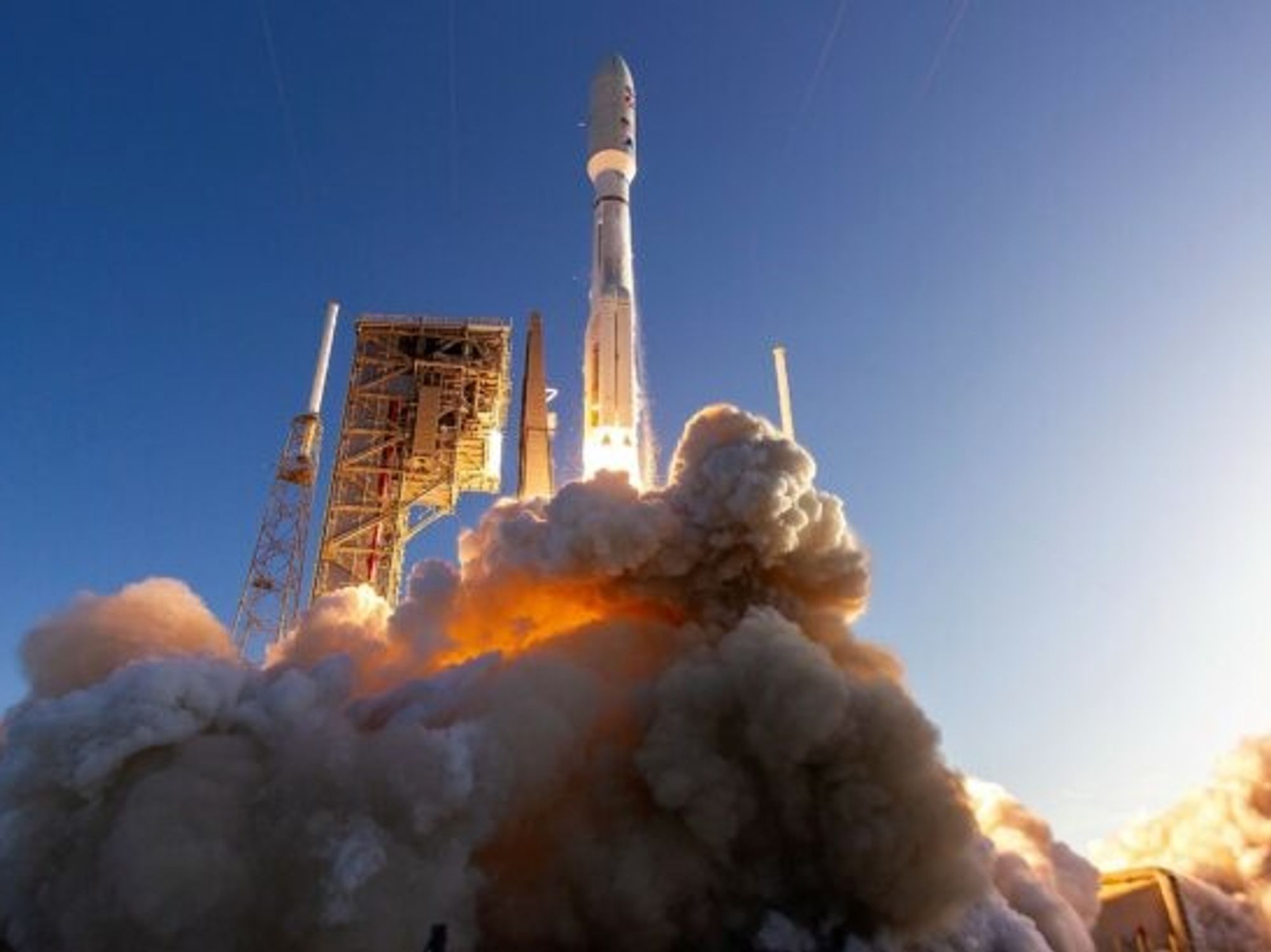Watch: NASA Perseverance Rover Blasts Off to Mars in Search of Alien Life
GeekWire contributing editor Alan Boyle is an award-winning science writer and veteran space reporter. Formerly of NBCNews.com, he is the author of "The Case for Pluto: How a Little Planet Made a Big Difference." Follow him via CosmicLog.com, on Twitter @b0yle, and on Facebook and MeWe.

With the fiery flash of a rocket launch, NASA's Perseverance rover headed out today for what's expected to be a decade-long campaign to store up and bring back Martian samples that may hold evidence of alien life.
United Launch Alliance's Atlas 5 rocket lifted off from Cape Canaveral Air Force Station in Florida at 7:50 a.m. ET (4:50 a.m. PT), sending the rover into space for a seven-month cruise to Mars.
Access to the area surrounding the launch pad was restricted due to the pandemic, but hundreds of thousands of people watched the liftoff via streaming video. And as if the pandemic wasn't enough of a challenge, in the minutes before launch, a magnitude-4.2 earthquake rattled through NASA's Jet Propulsion Laboratory in Pasadena, Calif., where the rover mission is managed.
Mission managers said the complications had no effect on the countdown.
"This is all about perseverance," NASA Administrator Jim Bridenstine said during the buildup to liftoff. "Going to Mars is all about persevering in general. Doing it now is more persevering than ever before."
An hour after launch, Perseverance's spacecraft separated from the Atlas 5's Centaur upper stage and flew outward to the Red Planet. NASA said the signal from the spacecraft was initially "too loud for the antennas on Earth." But in the midst of a post-launch news briefing, deputy project manager Matt Wallace reported that the operations team was eventually able to lock onto the signal properly.
Thomas Zurbuchen, the associate administrator of NASA's Science Mission Directorate, said such adjustments came with the territory. "You want to be a rocket scientist, this is what you do. … You have to have a little bit of nerves if you're in this business," he said.
Adam Steltzner, the mission's chief engineer at JPL, said he expected in-space operations to settle into a routine. "I'm looking forward to, ideally, a very quiet and boring cruise to Mars, as we prepare for the never-boring and always stressful entry, descent and landing on the 18th of February," he said on NASA TV.
Mars 2020 launchwww.youtube.com
Like its older cousin, NASA's Curiosity rover, Perseverance will land with the aid of parachutes and a retrorocket-equipped descent stage. A "Sky Crane" will lower the 1-ton rover to the surface of Jezero Crater, and then the descent stage will blast itself away from the landing site.
The six-wheeled, nuclear-powered robot is designed for a primary mission lasting at least one Martian year, which is the equivalent of nearly two Earth years. But if Perseverance follows Curiosity's example, it could be on the job for far longer.
Perseverance bears a strong resemblance to Curiosity, in that they're built on the same basic chassis with a similar-looking camera mast and robotic arm. NASA and its collaborators have added some new twists, however.
A mini-helicopter called Ingenuity is tucked under Perseverance's belly and will be deployed for unprecedented test flights after the landing. Another experiment called MOXIE will test a technique for turning the carbon dioxide in Mars' thin atmosphere to oxygen. That trick will come in handy if and when NASA sends astronauts on extended trips to Mars as is planned in the 2030s.
The biggest difference between Curiosity and Perseverance is that the new rover's scientific instruments are fine-tuned to look for signs of life on the microscopic scale.
A laser-equipped camera system called SuperCam can detect organic compounds in rocks and soils from a distance of more than 20 feet. Two close-up imaging systems, SHERLOC and PIXL, can theoretically make out the structural and chemical signs of fossilized microbes. And a radar imager called RIMFAX can map subsurface structure at a resolution of inches, to depths as deep as 30 feet.
Mission Overview: NASA's Perseverance Mars Roverwww.youtube.com
The target landing site in Jezero Crater is thought to have been a river delta in ancient times, and it was chosen in hopes that the minerals in Martian rock would preserve fossils — or at least the chemical evidence of biological processes.
It's unlikely that Perseverance will find indisputable evidence of life on Mars. Debates about Martian life detection tend to end inconclusively, whether we're talking about the Viking lander missions of the 1970s or suggestions of "nanofossils" in Martian meteorites that fell to Earth. But this mission has a long-term strategy for settling such debates.
Perseverance is designed to drill out and save dozens of promising core samples for later pickup. The current plan, which is still under development by NASA and the European Space Agency, calls for sending out a NASA lander and a European-built rover in 2026. That rover would fetch the samples and put them into a capsule, which would in turn be loaded onto a mini-rocket and launched into Martian orbit.
"It's kind of an interplanetary relay race we're doing," David Parker, ESA's director of human and robotic spaceflight, explained during a pre-launch briefing.
Yet another spacecraft would take a trip to Martian orbit, capture the capsule and bring the samples back to Earth for study in 2031. That would mark the first opportunity to examine fresh samples from Mars with the best instruments that scientists have at their disposal — and the best opportunity to answer the age-old question about life on Mars..
"I do believe that the ultimate proof and the ultimate analyses that are really critical to that question, at the level of standard that we need to answer this, will come from laboratory analysis on Earth," said Thomas Zurbuchen, associate administrator for NASA's Science Mission Directorate. "So I believe this will be a process that will extend over 10 years or so, where evidence is mounting from remote sensing and in-situ measurements up there, but then really culminating in bringing these samples back."
More morsels about the Mars mission:
- Both Perseverance and Ingenuity were named by students who participated in essay contests — and as a reward, Virginia seventh-grader Alex Mather (who named the rover) and Alabama high-school junior Vaneeza Rupani (who named the helicopter) are attending the launch with their families at NASA's invitation.
- Speaking of names, Perseverance is carrying three stamp-sized chips that bear the micro-etched names of nearly 11 million people who responded to NASA's online "Send Your Name to Mars" campaign. The campaign has been revived to collect more names to be sent aboard the next Mars probe.
- Perseverance is also carrying a 3-by-5-inch plaque that pays tribute to healthcare workers and their work to quell the coronavirus pandemic. The COVID-19 Perseverance Plate bears the serpent-and-staff symbol of the medical profession, topped by planet Earth.
- The spacecraft is equipped with microphones that scientists hope will pick up the sounds associated with Perseverance's descent and landing, as well as the zapping sounds created by the SuperCam's laser blasts. Perseverance is the third Mars probe to carry a microphone, but setbacks prevented the microphones from being used during the two earlier missions (Mars Polar Lander in 1999 and Phoenix Mars Lander in 2008).
- Perseverance is the last of three Mars missions to take advantage of this month's favorable launch opportunity — an opportunity that comes around only once every 26 months, due to the relative orbital positions of Earth and Mars. The other two are the United Arab Emirates' Hope orbiter mission, and China's Tianwen-1 mission, which involves an orbiter, lander and rover.
GeekWire contributing editor Alan Boyle is an award-winning science writer and veteran space reporter. Formerly of NBCNews.com, he is the author of "The Case for Pluto: How a Little Planet Made a Big Difference." Follow him via CosmicLog.com, on Twitter @b0yle, and on Facebook and MeWe.





 Image Source: Perelel
Image Source: Perelel